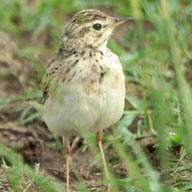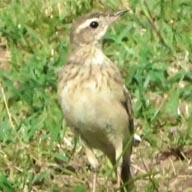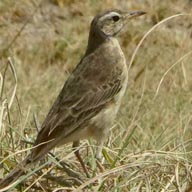The pipits are a cosmopolitan genus, Anthus, of small passerine birds with medium to long tails. Along with the wagtails and longclaws, the pipits make up the family Motacillidae. The genus is widespread, occurring across most of the world, except the driest deserts, rainforests and the mainland of Antarctica.
They are slender, often drab, ground-feeding insectivores of open country. Like their relatives in the family, the pipits are monogamous and territorial. Pipits are ground nesters, laying up to six speckled eggs.
The genus has more than forty species, making it the largest genus in terms of numbers in its family. The exact species limits of the genus are still a matter of some debate.
Molecular studies of the pipits suggest that the genus arose in East Asia around seven million years ago (mya), during the Miocene, and that the genus had spread to the Americas, Africa and Europe between 5 and 6 mya. Speciation rates were high during the Pliocene (5.3 to 2.6 mya ) but have slowed down so during the Pleistocene. Repeated dispersal between continents seems to have been important in generating new species in Eurasia, Africa and North America, rather than species arising by radiation once a continent was reached. In South America, however, vicariance appears to have played an important role in speciation.
The pipits are generally highly conservative in appearance. They are generally between 6.3–8.3 inches in length, although the smallest species, the short-tailed pipit, is only 4.5–4.9 in. In weight they range from 0.53–1.34 oz. Like all members of the family they are slender, short necked birds with long tails, long slender legs with elongated (in some cases very elongated) hind claws. The length of the hindclaw varies with the habits of the species, more arboreal species have shorter, more curved hindclaws than the more terrestrial species. The bills are generally long, slender and pointed.
The plumage of the pipits is generally drab and brown, buff or faded white. The undersides are usually darker than the top, and there is a variable amount of barring and streaking on the back, wings and breast. The drab mottled brown colors provide some camouflage against the soil and stones they are generally found on. A few species have slightly more colorful breeding plumages, for example the rosy pipit has greenish edges on the wing feathers.
Pipits are morphologically similar to some larks. However the two groups are quite distantly related: the lark family Alaudidae is part of the Sylvioidea superfamily, rather than the Passeroidea, where the pipits are placed.
Richard's pipit Anthus richardi
Paddyfield pipit Anthus rufulus
African pipit Anthus cinnamomeus
Australasian pipit Anthus novaeseelandiae
Plain-backed pipit Anthus leucophrys
Buffy pipit Anthus vaalensis
Long-legged pipit Anthus pallidiventris
Wood pipit Anthus nyassae
Malindi pipit Anthus melindae
Kimberley pipit Anthus pseudosimilis
Tawny pipit Anthus campestris
Blyth's pipit Anthus godlewskii
Berthelot's pipit Anthus berthelotii
Long-billed pipit Anthus similis
Jackson's pipit Anthus latistratus
Short-tailed pipit Anthus brachyurus
Bushveld pipit Anthus caffer
Tree pipit Anthus trivialis
Nilgiri pipit Anthus nilghiriensis
Olive-backed pipit Anthus hodgsoni
Pechora pipit Anthus gustavi
Meadow pipit Anthus pratensis
Red-throated pipit Anthus cervinus
Rosy pipit Anthus roseatus
Water pipit Anthus spinoletta
Eurasian rock pipit Anthus petrosus
Buff-bellied pipit Anthus rubescens
Upland pipit Anthus sylvanus
Sprague's pipit Anthus spragueii
Short-billed pipit Anthus furcatus
Hellmayr's pipit Anthus hellmayri
Yellowish pipit Anthus lutescens
Pampas pipit Anthus chacoensis
Correndera pipit Anthus correndera
Ochre-breasted pipit Anthus nattereri
Paramo pipit Anthus bogotensis
South Georgia pipit Anthus antarcticus
Alpine pipit Anthus gutturalis
Sokoke pipit Anthus sokokensis
African rock pipit Anthus crenatus
Striped pipit Anthus lineiventris
Yellow-breasted pipit Anthus chloris
Long-tailed pipit Anthus longicaudatus
Mountain pipit Anthus hoeschi

ComingsBirds.com/KenyaTanzaniaL-Z
To the Beauty of Birds

- Home Kenya and Tanzania Birds
- LAPWINGS AND PLOVERS (9)
- LARKS (6)
- LONGCLAWS (4)
- Lovebird Fischer's
- Lovebird Yellow-collared
- Mannikin Bronze
- Mannikin Rufous backed Black and White
- Martin Rock
- Moorhen Common
- Morning-thrush Spotted
- MOUSEBIRDS (4)
- Nightjar Slender-tailed
- Oriole Black-headed
- Ostrich
- OWLS (3)
- Oxpecker Red-billed
- Parrot African Orange Bellied
- Parrot Brown
- Pelican Great White
- Pelican Pink-backed
- PIPITS (3)
- Puffback Pringle's
- Pytilla Green-winged
- Raven White-napped
- Robin-chat Cape
- Robin-chat White-browed
- Roller Lilac-breasted
- Rook Cape
- SANDGROUSE (3)
- Sandpiper Curlew
- Scimitarbill Abyssinian
- Scrub-robin White-browed
- Secretary Bird
- SEEDEATERS (3)
- Shrike Magpie
- Shrike Northern White-crowned
- Silverbird
- Social-Weaver Grey-capped
- Social-weaver Black-capped
- Sparrow-Lark Fischer's
- Sparrow-Weaver Donaldson-Smith's
- Sparrow-Weaver White-browed
- SPARROWS (6)
- Spoonbill African
- STARLINGS (9)
- Stilt Black-winged
- Stent Little
- Stone-chat Common
- STORKS (4)
- SUNBIRDS (13)
- SWALLOWS (3)
- Swift Little
- Swamphen Purple
- Tchagra Brown-crowned
- TEALS (3)
- Tern Gull-billed
- THICK-KNEES (2)
- THRUSHES (3)
- Tinkerbird Yellow-rumped
- Tit Mouse-colored Penduline
- Tit White-bellied
- Trogon Bartailed
- Trogon Narina
- VULTURES (4)
- WAGTAILS (3)
- Warbler Grey-capped
- Warbler Red-fronted
- WAXBILLS (4)
- WEAVERS A-G (11)
- WEAVERS H-Z (11)
- Wheatear Capped
- Wheatear Schalow's
- White-eye Montane
- White-eye Yellow
- Whydah Pin-tailed
- WIDOWBIRDS (4)
- Wood-hoopoe Violet
- Wood-hoopoe White-headed
- Woodpecker Grey
- Woodpecker Nubian
- template



© 2014 David Comings Contact Me